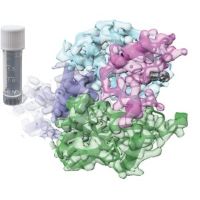Specification
| Description | Recombinant protein from the full-length sequence of Homo sapiens SERPINE1 mRNA binding protein 1 (SERBP1), transcript variant 1 (NM_001018067). |
| Organism | Homo sapiens (Human) |
| Expression Host | Human Cells |
| Tag Info | His or DYKDDDDK. Please contact us if you need further information or require specific designed tag. |
| Purity | Greater than 90% by SDS-PAGE gel |
| Uniprot ID | Q8NC51 |
| Entry Name | PAIRB_HUMAN |
| Gene Names | SERBP1 PAIRBP1 CGI-55 |
| Alternative Gene Names | PAIRBP1 |
| Alternative Protein Names | Plasminogen activator inhibitor 1 RNA-binding protein (PAI1 RNA-binding protein 1) (PAI-RBP1) (SERPINE1 mRNA-binding protein 1) |
| Application | Antigens, Western, ELISA and other in vitro binding or in vivo functional assays, and protein-protein interaction studies; For research & development use only! |
| Buffer | Purified protein formulated in a sterile solution of PBS buffer, pH7.2, without any preservatives |
| Endotoxin | Endotoxin level is < 0.1 ng/µg of protein (<1EU /µg) |
| Length | 408 |
| Molecular Weight(Da) | 44965 |
| Protein Sequence | (The sequence of expressed protein may have some variation from the sequence shown below. Please contact us for the exact sequence.) MPGHLQEGFGCVVTNRFDQLFDDESDPFEVLKAAENKKKEAGGGGVGGPGAKSAAQAAAQTNSNAAGKQLRKESQKDRKNPLPPSVGVVDKKEETQPPVALKKEGIRRVGRRPDQQLQGEGKIIDRRPERRPPRERRFEKPLEEKGEGGEFSVDRPIIDRPIRGRGGLGRGRGGRGRGMGRGDGFDSRGKREFDRHSGSDRSSFSHYSGLKHEDKRGGSGSHNWGTVKDELTESPKYIQKQISYNYSDLDQSNVTEETPEGEEHHPVADTENKENEVEEVKEEGPKEMTLDEWKAIQNKDRAKVEFNIRKPNEGADGQWKKGFVLHKSKSEEAHAEDSVMDHHFRKPANDITSQLEINFGDLGRPGRGGRGGRGGRGRGGRPNRGSRTDKSSASAPDVDDPEAFPALA |
Background
| Function | FUNCTION: May play a role in the regulation of mRNA stability. Binds to the 3'-most 134 nt of the SERPINE1/PAI1 mRNA, a region which confers cyclic nucleotide regulation of message decay. Seems to play a role in PML-nuclear bodies formation (PubMed:28695742). {ECO:0000269|PubMed:11001948, ECO:0000269|PubMed:28695742}. |
| Pathway | |
| Protein Families | |
| Tissue Specificity | Expressed at high level in the heart, skeletal muscle and kidney, and at low levels in placenta, liver and brain. {ECO:0000269|PubMed:12505151}. |
QC Data
| Note | Please contact us for QC Data |
| Product Image (Reference Only) |  |

